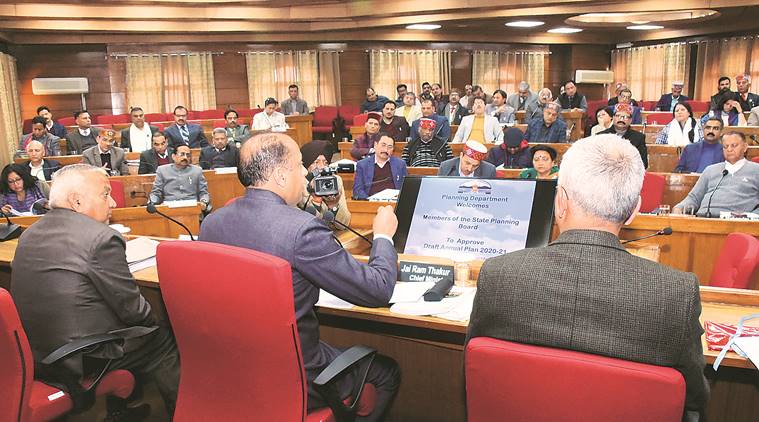 CM Jai Ram Thakur presides over the state planning board meeting in Shimla on Monday.(Express Photo)
CM Jai Ram Thakur presides over the state planning board meeting in Shimla on Monday.(Express Photo)
The Himachal Pradesh State Planning Board Monday approved an annual plan of Rs 7,900 crore for the 2020-21 fiscal, which is nearly 11 per cent higher than that of current financial year.
The annual plan includes a general plan of Rs 5,111 crore and scheduled castes, tribal area and backward area sub-plans of Rs 1,990 crore, Rs 711 crore, and Rs 88 crore, respectively.
The social services sector, which includes health and education, has been given the highest priority with a proposed outlay of nearly Rs 3,500 crore, constituting around 44 per cent of the total plan and an increase of Rs 439 crore from current year. It’s followed by transport and communication sector at 17.6 per cent, agriculture and allied activities at 12.3 per cent, irrigation and flood control at 6.4 per cent, energy at 6.3 per cent (down from 10 per cent), and general economic services at 6.1 per cent of the total outlay. Rural development, general services, industry and minerals, science, technology and environment and special area programmes have been accorded less than 3.5 per cent each.
The plan targets to achieve around 16,75,000 metric tonnes of food grain production and 16,58,000 metric tonnes of vegetable production during the fiscal. The target for fruit production is 8.36 lakh MT while that for milk is 16,20,000 tonnes. The target for wool production is 1500 tonnes.
In the power sector, the plan has set a target of 10,393 mega units to be sold within the state and 587 MU to be sold outside. The plan also aims to achieve the construction of 925 kilometres of motorable roads and connect 90 more villages.
Under the Rural Infrastructure Development Fund (RIDF), major schemes in soil and water conservation, irrigation, water supply, and roads and bridges are covered which are to be financed through NABARD, the plan said. The proposed outlay for RIDF programmes is around Rs 834 crore or 10.5 per cent of the total plan outlay.
According to the plan, Externally Aided Projects (EAPs) are being implemented in various sectors such as agriculture, forests and tourism with assistance from the World Bank, ADB, Japan International Cooperation Agency (JICA) etc and the outlay for these projects is Rts 933 crore or 11.8 per cent of the plan, with the largest chunk proposed for power projects to the tune of Rs 344 crore.
There are 3,226 panchayats in Himachal out of which 559 have been declared backward, mostly in the districts of Mandi, Chamba, Shimla and Kullu. The backward area sub-plan, with a proposed outlay of Rs 88 crore, will focus on construction of seed stores and other agricultural/horticultural stores, veterinary institutional buildings, water supply and irrigation schemes, school buildings, healthcare institutions and link roads and bridges, among other things.
Tribal (or scheduled) areas constitute around 42.5 per cent of the state while 5.7 per cent of the total population is tribal, the plan said, adding that the tribal area sub-plan outlay has been increased from Rs 639 crore to Rs 711 crore.
Under the scheduled caste sub-plan, the outlay is Rs 1999 crore or 25.19 per cent of the total plan equivalent to the ratio of the SC population in the state. The plan said that the state government has transferred all subjects related to SC sub plan and other related schemes to the Social Justice and Empowerment Department, the nodal department for the socio-economic development of the SC population. The objectives of the sub-plan include improvement of employability, eradication of illiteracy, special education/technical skills and entrepreneurial training, among other things. The plan said that Himachal has taken several steps to develop decentralised planning to ensure adequate involvement of people through programmes such as Vikas Mein Jan Sahyog (VMJS).
‘Emphasis to be laid on raising farm income’
Chief minister Jai Ram Thakur, who presided over the meeting of the Board, said that since 90 per cent of the population lives in rural areas, there should be emphasis on increasing crop production, raising the farm income, bringing more area under irrigation, undertaking research in the farm sector and promoting cultivation of high-yielding crops. He added that farmers should be encouraged to adopt principles of natural farming to get a higher produce and improve the health of the soil at the same time.
Thakur said that Himachal has made strides in various spheres, especially education, but expressed concern over the gap between male and female literacy rates.
He said that the per capita income of state was better than the national average. It was Rs 1,76,968 in 2018-19 and had shown an increase of 10.12 per cent from 2017-18.
Thakur said that one way to enhance the empowerment of women was through greater participation in self help groups. He added that around 80 panchayats in the state remain to be connected with roads.